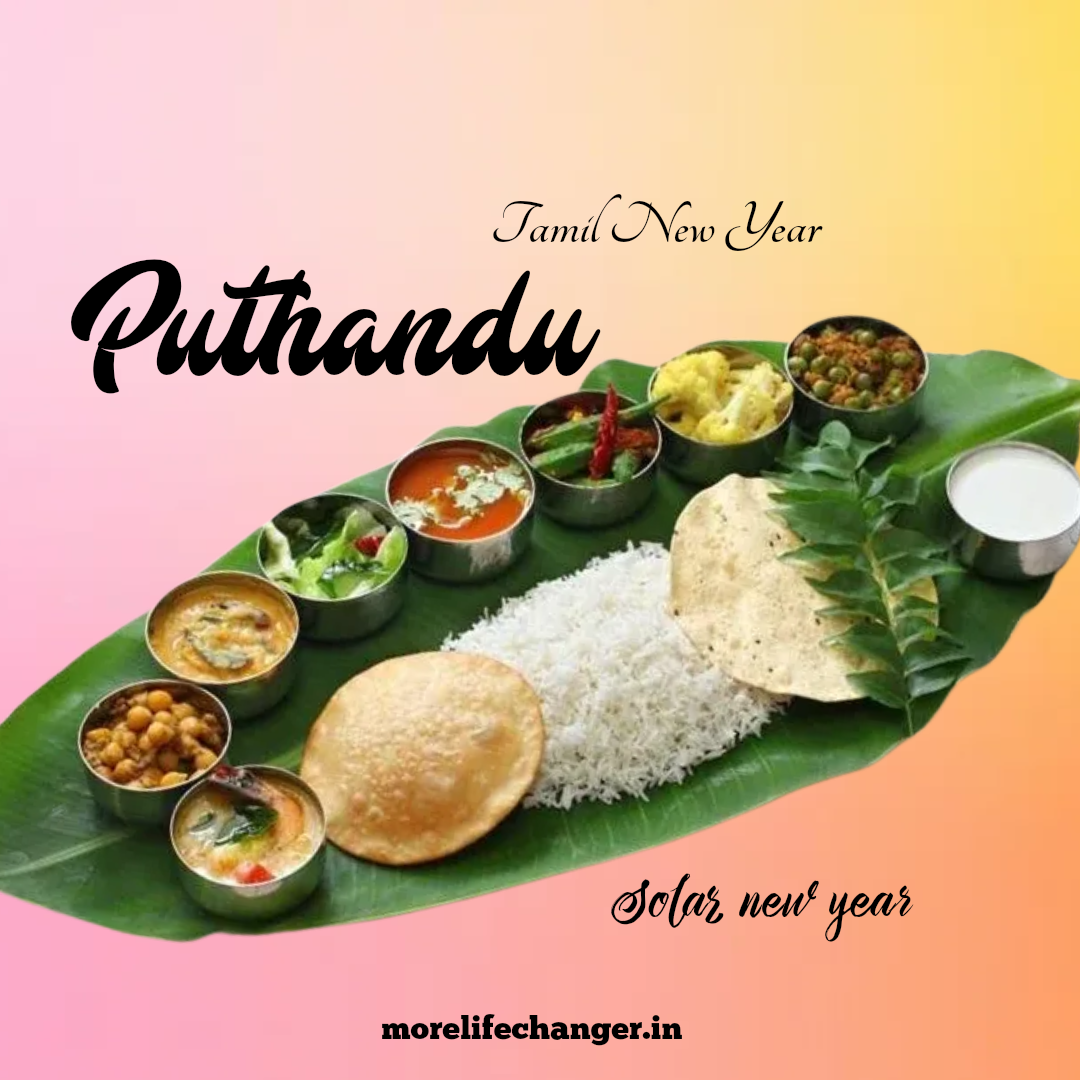Puthandu, also known as Tamil New Year, is the traditional new year festival celebrated by the Tamil community, primarily in the Indian state of Tamil Nadu and among Tamil-speaking people worldwide. It marks the first day of the Tamil calendar year, which usually falls on April 14th or 15th, coinciding with the solar transition when the Sun enters Aries (Mesha Rashi).
Significance of Puthandu
Puthandu is deeply significant in Tamil culture as it symbolizes a fresh start and the renewal of life. It is both a cultural and religious event, and it marks a time for family reunions, spirituality, and community celebrations.
- Solar New Year:
- Puthandu marks the beginning of the Tamil solar calendar year. This transition is associated with the Sun’s entry into Aries and is celebrated across many regions of India, though each region may observe the occasion with different customs and rituals.
- Spiritual Significance:
- The day is believed to bring good fortune, and it is considered an auspicious time to start new ventures or make significant life decisions.
- People worship and pray for prosperity, good health, wealth, and happiness in the coming year.
Customs and Traditions
1. Visiting Temples:
- On Puthandu, it is customary for people to visit temples to offer prayers, seek blessings from the gods, and show gratitude for the past year. Lord Vishnu and Lord Shiva are often worshipped during this time, along with the family deities.
2. Kani (New Year’s Day Ritual):
- The “Kani” ritual is an important part of the Puthandu celebrations. On the eve of the festival, families prepare an altar with symbolic items for good luck and prosperity, such as:
- Fresh fruits (particularly mangoes and bananas),
- Auspicious yellow flowers like mango leaves,
- Gold jewelry or coins,
- New clothes, and
- A mirror.
- The family members wake up early on Puthandu morning, look at the “Kani” (the items laid out on the altar), and offer prayers. This ritual is believed to bring prosperity in the coming year.
3. Puthandu Feast:
- The celebration involves preparing a grand feast with special dishes that reflect the harvest of the season. Traditional foods include:
- Pongal (a sweet or savory rice dish made with rice, lentils, and spices),
- Vada (fried lentil doughnuts),
- Payasam (a sweet pudding made from rice or lentils),
- Avial (a vegetable dish with yogurt and coconut).
- Puthandu Saapadu (New Year’s meal) is enjoyed with family and friends, and sweets symbolize a sweet start to the new year.
4. New Clothes:
- Wearing new clothes is a central tradition of Puthandu, symbolizing a fresh beginning and starting the year with positivity. The new attire is often bright and festive, reflecting the joy of the occasion.
5. Kolam (Rangoli):
- Kolam, the traditional floor art, is created in front of homes. Women often draw kolams using rice flour or colored powders, which are believed to bring prosperity and good luck to the household.
6. Family and Community Celebrations:
- Puthandu is a time for family gatherings, where people reconnect with relatives, exchange gifts, and enjoy the festive atmosphere. In Tamil Nadu, cultural programs and traditional music and dance (like Bharatanatyam and Carnatic music) are often performed.
- Parades and community events are also common in major cities where Tamil communities reside, especially in countries like Sri Lanka, Malaysia, Singapore, and Mauritius.
7. Traditional Music and Dance:
- The day is often marked by traditional folk songs, dances, and theater performances that celebrate Tamil culture. Silambam (a traditional Tamil martial art), Karagattam (a folk dance), and Kummi (a traditional group dance) are performed during the festivities.
Also read: Solar New Year
Cultural and Historical Context of Puthandu
Puthandu, also known as Tamil New Year, is a celebration that goes beyond just the marking of a new year. It is deeply rooted in Tamil culture, history, and traditions, making it an important festival for Tamil-speaking people both in India and across the world.
The Tamil calendar is a solar calendar, and Puthandu is celebrated when the Sun moves into Aries (Mesha Rashi) from Pisces (Meen Rashi), which marks the beginning of the Chithirai month in the Tamil calendar. This corresponds to mid-April in the Gregorian calendar. The day is often seen as the start of the harvest season and symbolizes the arrival of spring, a time of renewal and growth.
Traditional Rituals and Beliefs
1. The Ritual of ‘Kani’
The most unique and significant ritual of Puthandu is the “Kani” or first sight. In the early hours of Puthandu, Tamil families set up a ritualistic arrangement of auspicious items on a tray, which is typically placed in front of a mirror. These items include:
- Fresh fruits, particularly mangoes (symbolizing the harvest),
- Gold jewelry or coins (symbolizing prosperity),
- A new cloth (representing a fresh start),
- Flowers, especially mango leaves,
- A mirror (to reflect the positive qualities of life).
The idea behind the Kani is that the first sight one sees on the new year morning should be auspicious, and it’s believed to set the tone for the rest of the year. Family members are encouraged to gaze upon the Kani as soon as they wake up to ensure a prosperous year ahead.
2. Visiting Temples
On Puthandu, visiting temples is an important ritual. People head to temples to offer prayers to Lord Vishnu, Lord Shiva, and family deities (known as Kula Deivam). Special Poojas (prayers) are conducted, and devotees seek blessings for the well-being of their family, prosperity, and health.
At the temples, you may also find large crowds of people wearing their finest clothes, offering fruits, sweets, and flowers at the altar. The temples are often beautifully decorated with garlands, lights, and mango leaves to mark the occasion.
3. Puthandu Feast (Puthandu Saapadu)
The meal is an important part of the Puthandu celebration. The Puthandu feast usually includes several special dishes that hold both symbolic and cultural significance:
- Pongal (a rice dish prepared with lentils and seasoned with ghee and black pepper). It is often offered as part of the rituals at the temple, as it signifies prosperity and gratitude for the harvest.
- Avial (a vegetable dish made with a variety of vegetables, coconut, and yogurt, often seasoned with curry leaves).
- Vadai (savory fried doughnuts made from lentils, often served with chutneys).
- Payasam or Kheer (a sweet pudding made from rice, milk, and sugar, often flavored with cardamom, raisins, and cashews). It represents the sweetness of life in the new year.
Another famous food associated with Puthandu is the “Puthandu Prasadam”, which includes sweets, fruits, and offerings for the deities.
4. Kolam (Rangoli)
One of the key visual elements of Puthandu celebrations is the creation of Kolam (or Rangoli) in front of the house. Kolam is a form of traditional art created using rice flour, colored powders, or chalk. It is believed that drawing Kolam designs outside the house brings good fortune and prosperity. Kolams are usually drawn by women, and designs can range from simple geometric shapes to intricate patterns of flowers, animals, and other symbols of luck.
5. Exchanging Gifts and Greetings
On Puthandu, it is customary for people to greet each other with the phrase, “Puthandu Vazthukal” (which means “Happy New Year” in Tamil). Families and friends exchange gifts and sweets to celebrate the occasion and to wish each other well for the year ahead. It is also a time when younger members of the family pay respects to the elders by offering ‘padapuja’ (a ritual touching of the feet), which symbolizes respect and the seeking of blessings.
6. Community Celebrations and Cultural Programs
Puthandu is widely celebrated within Tamil communities, and the celebrations can extend beyond the family to community gatherings. These can include public parades, cultural programs, and performances of traditional Tamil music, dance, and theater. For instance, Bharatanatyam (classical dance) performances, Carnatic music concerts, and folk dances are often held to celebrate the spirit of the occasion.
In places with a large Tamil diaspora, such as Sri Lanka, Singapore, Malaysia, and Mauritius, Puthandu is celebrated with similar fervor. These communities also hold temple festivals and organize public events where people gather to celebrate the new year together.
7. Fireworks and Festive Atmosphere
In many parts of Tamil Nadu, Puthandu is marked by fireworks or crackers. The loud noises are believed to ward off evil spirits and bring in good energy for the year. People often enjoy these displays in their homes or public parks, adding to the festive atmosphere.
Puthandu in Modern Times
While Puthandu remains a deeply rooted cultural tradition, it has also evolved in modern times. Urban areas see the use of social media to connect with family and friends, and many people in the Tamil diaspora continue to celebrate this festival with regional variations, but with the same core practices and significance.
Similar Festivals in Other Regions:
- Vishu: Celebrated in Kerala with some similar customs like the Kani ritual, but it marks the beginning of the Malayalam New Year and usually falls around April 14th.
- Baisakhi: Celebrated in Punjab, it marks the harvest season and the start of the new year in the Baisakh month of the solar calendar.
- Baisakh: Observed in Bengal, this is another solar new year celebration on or around April 14th.
Please join discussion on Facebook about world facts and its secret .

